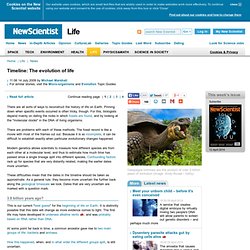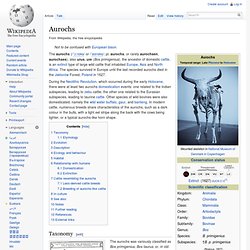

BBC Nature - History of life on Earth. Timeline: The evolution of life. Read full article Continue reading page |1|2|3|4 There are all sorts of ways to reconstruct the history of life on Earth.

Pinning down when specific events occurred is often tricky, though. For this, biologists depend mainly on dating the rocks in which fossils are found, and by looking at the "molecular clocks" in the DNA of living organisms. There are problems with each of these methods. Modern genetics allows scientists to measure how different species are from each other at a molecular level, and thus to estimate how much time has passed since a single lineage split into different species. These difficulties mean that the dates in the timeline should be taken as approximate. 3.8 billion years ago? This is our current "best guess" for the beginning of life on Earth. . , and was probably based on RNA rather than DNA. At some point far back in time, a common ancestor gave rise to two main groups of life: bacteria and archaea. 3.5 billion years ago 3.46 billion years ago 3.4 billion years ago.
Mesozoic. Paleolithic Murals and the Global Wildlife Trade. Stone age fishing altered ocean wildlife populations more than previously believed. By Elizabeth Weise, USA TODAY 's oceans once teemed with life.

In , for example, blue whales, orcas and sharks filled the waters, porpoises explored rivers looking for fish and dolphins swam near the coast. But new research finds that it wasn't the advent of mechanized fishing in the late 19th and that emptied the oceans of many of their native creatures. Instead, human-caused changes came much earlier than previously thought, finds an extensive effort by marine historians to reconstruct the seas' past life.
"Fishing on a large scale happened much earlier than we'd thought previously and with significantly more impact than one would have thought 10 years ago," says Poul Holm, professor at , and chairman of the History of Marine Animal Population project. Pleistocene megafauna. North America South America.

The Last Great Auk. The black and white Great Auk was a beautiful bird of bizarre proportions.

Its ribbed beak was huge and unwieldy, its legs were too short and its stubby wings were far too small to carry its big body into the air. In these regards, the Great Auk’s clumsy appearance rivals that of the Dodo. And that’s not the only thing these two birds have in common. For the Great Auk too, was driven extinct by human cruelty and carelessness. The Rate of Extinction: 3 Species per Hour. About 6 waves of massive extinction are known in the history of the Earth.

The last one wiped out the dinosaur world 65 million years ago and was probably due to a meteorite collision. But the recent one has no natural causes. It is man made and rampant, eliminating three animal or plant species every hour. Scientists and environmentalists issued reports about threats to creatures and plants including right whales, Iberian lynxes, wild potatoes and even wild peanuts. Experts gathered on May 22, at the International Day for Biological Diversity, a report on the threatened species from whales and Iberian lynxes to wild potatoes and wild peanuts. The threats to the wildlife diversity vary from habitat loss due to land clearance for farms or cities, poaching, pollution and rising human populations to global warming.
Determination at all levels - global, national and local," he said. UE's goal is to stop biodiversity loss by 2010, not just to slow down the process. Extinct ibex is resurrected by cloning. It has also increased the possibility that it will one day be possible to reproduce long-dead species such as woolly mammoths and even dinosaurs.

Dr Jose Folch, from the Centre of Food Technology and Research of Aragon, in Zaragoza, northern Spain, led the research along with colleagues from the National Research Institute of Agriculture and Food in Madrid. He said: "The delivered kid was genetically identical to the bucardo. In species such as bucardo, cloning is the only possibility to avoid its complete disappearance. " Pyrenean ibex, which have distinctive curved horns, were once common in northern Spain and in the French Pyrenees, but extensive hunting during the 19th century reduced their numbers to fewer than 100 individuals. 11 Extinct Animals That Have Been Photographed Alive. Animals Published on April 2nd, 2009 | by Bryan Nelson The current rate of extinction is 100 to 1000 times higher than the average, or background rate, making our current period the 6th major mass extinction in the planet’s history.

Although fossil reconstructions or pictorial representations can sometimes be difficult to connect with, it’s impossible to ignore the experience of seeing a photograph of an animal on the brink of extinction. Thus, what follows is a list of 11 extinct animals that were photographed while still alive. Tasmanian Tiger. Aurochs- the ancestor of domesticated cattle. The aurochs (/ˈɔːrɒks/ or /ˈaʊrɒks/; pl. aurochs, or rarely aurochsen, aurochses), also urus, ure (Bos primigenius), the ancestor of domestic cattle, is an extinct type of large wild cattle that inhabited Europe, Asia and North Africa.
